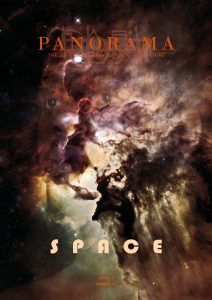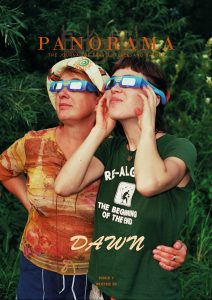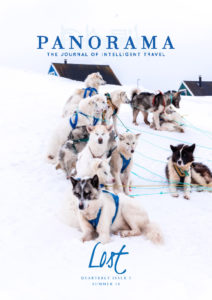Every pilgrim is familiar with trail blazes, and for long-distance walkers of any brand waymarking is something of an unreflective activity. But during the pilgrimage I and my husband took to Santiago, a chance encounter with a fellow pilgrim opened my mind to the deep phenomenological significance of blaze-marking.
“I’m the Camino Stalker,” Ken said with a chuckle as we took our coffee. Knowing he was blind I gave him a good sizing up. Undoubtedly there were some weirdos along the Way . . . my husband and I just hadn’t run into one yet. With his thin, athletic build, tiny ankles and graceful posture—not to mention those Blues Brothers specs he was sporting while we ate—he just didn’t seem to scream danger.
“Yeah?” Bal said coolly before taking a bite of his frittata. “Were you stalking us?”
Ken leaned in and smiled without shame, pointing at Bal’s shirt. “The only colour I can still see is red, my friend. You were my personal trail marker.”
After being diagnosed with a degenerative eye condition in his late thirties Ken found out fairly quickly that he would have to reinvent himself, down to his very vocation as a dancer with one of New York’s dance companies. He had spent his life on the stage. What was he to do now? In the face of his disease there were other things he had initially considered pursuing, but over the years since his diagnosis he found himself falling further into the habit of being cared for by his husband. “My world these past few years has been getting smaller and smaller,” he told us as we wrapped up our meal. “Before I could pursue any new path, I needed to find my way back to self-reliance.”
Hence here he was, just a few kilometres away from Ribadiso and a score more from Santiago, having walked all the way from St. Jean while surveilling strangers sporting red. The way he told it, his wayfaring system wasn’t without its comedic moments. It was his habit to wake at five each morning and sit in the square outside the church until someone with a red backpack walked by. One morning he identified his pilgrim-for-the-day-way-marker and stood up to hastily gather his gear. He didn’t get twenty feet before a group of school children swam into his line of vision like rosy red minnows coursing upstream. A sea of red and blood-orange backpacks surrounded him. “It might have been a scene in a Woody Allen movie,” he recounted with wry humour. That and patience were the keys to his success in getting this far. It wouldn’t be the only pilgrim he’d intended to follow and lost sight of, but this time it would be several hours before another passed by.
Ken’s journey is inspiring, but it’s also instructive, even to those of us pilgrims who have vision that lies in the range of normal depth and spatial and colour perception. All pilgrims course our direction by way of blaze markers that we, at the very onset of our journeys, begin quite naturally scanning our environment for.
The question is, does this process of reading the landscape through blazes change the pilgrim’s relationship with wherever in the blazes they are?
The design of the blazes set along the Caminos of Europe vary, country by country. Along Italy’s sections of the Francigena, the way markers are institutional signposts—brown trail maps and white stone bollards, the distances to Rome etched or painted in red. Through France, bands of white and red lines are used to communicate to pilgrims—this way, not this, go right, go back. Across the autonomous regions of Spain, often heavily graffitied and totemised mojones are tucked into the roadside here and there.
Yet along all these trails, and most notably along the highly traversed pilgrim paths of Spain, many other blazes have cropped up over the generations. Some of these, commissioned by city planners and district governments, are meant to be as permanent as all things can hope to be: brass shells sunk into cobblestone roads and sidewalks in cities, brass plates and roadside kilometre markers set on buildings and intersections at crossroads. Others, such as the roughly painted yellow arrows the pilgrim discovers on buildings, stiles, and trees, are the brushwork of homeowners and entrepreneurs, community members within smaller towns or villages, and volunteers within regional pilgrim associations. They have a shorter life, sanded out and bleached by seasons of sun, rain, frost, and wind.
But the great magnitude of these blazes—and the ones which are the highest interest to this phenomenologist—will be crafted anonymously. They will live out their purpose in the span of a day without much assistance by the elements, in the forms of cairns and arrows of flowers or stones on the side of the road, arrows or crosses woven into a fence. Anonymously created by those who have passed before, they sing come, the celebration is this way, before fading into the landscape of being once again.
Just southwest of Santillana del Mar, the Cuevas del Altamira lie sealed, their thousands of magnificent paintings once again protected from the elements, as they had been for 35,600 years before their rediscovery in the 1860s. There is very little material evidence of their creators’ way of life other than what the images they left reveal. Grinding up lime and charcoal, hematite and red ochre, yellow ochre and umber, these bands of hunter gatherers used the long bones of animals to blow negative reliefs of their hands onto the walls with the coloured dust, or bound the pigments to animal fat in order to paint. The bestiary reveals scenes from a people’s life of husbandry and hunting. They feature the animals with whom the people had a kinship. There are horses and aurochs, the ancient Eurasian ox which was the ancestor of modern cattle. Like figures in a Marc Chagall painting the animals float over the surfaces, weightless among images of bison and ibices, red deer stags and hinds. Peeking out, here and there, semi-human faces and signs whose meanings are lost to history emerge as well.

Sign within Cueva del Altamira. Photograph by P. Saura. Museo de Altamira.
For every image that is preserved in the cave, there were countless others lost to the elements—those messages placed in the grass or at the edge of a grazing path, painted onto fieldstone or carved into trees along a migratory trail. This is what remains of a people’s communication, of their way of life.
Most pilgrims who journey along the Camino Norte will not detour to visit the Museo de Altamira, which houses replicas of the cave’s markings. They will not turn southwest to pause and acknowledge our ancestors’ creations or their continued presence on the land. But many of them will create or encounter blazes along the trail. In this, they will participate in the ancient practice of pictography that brought those utterances into being, without ever even knowing it.
The question at the heart of this essay is whether pilgrims’ development and use of blazes alter their relationship with the land community. If you can believe it, one possible answer to the question is bound to the history of language itself—how it evolved as a technology, and how our cognitive processes evolved with language’s evolution.
As philosopher David Abram notes in The Spell of the Sensuous,
All of the early writing systems of our species remain tied to the mysteries of a more-than-human world. The petroglyphs of pre-Columbian North America abound with images of prey animals, of rain clouds and lightning, of eagle and snake, of the paw prints of bear. On rocks, canyon walls, and caves these figures mingle with human shapes, or shapes part human and part Other (part insect, or owl, or elk.)
Thousands of years after the paintings of Altamira were created, civilizations were still creating languages that reflected a sense of being in the world. The Sumerians were the first to develop a written language system around 3500 BCE. When they did, words and small units of meaning were communicated through recognizable symbols of things in the world. For instance, they communicated the concept of Earth by carving an orb into stone and running it through with lines, perhaps to suggest its density, or rows of crops. The concept of going or coming they communicated through the outline of a foot lifted off the ground.
Long after the Sumerians had passed the way of all things and their language was written off as “dead,” pictographic systems such as ancient Chinese, Mayan, and other indigenous Mesoamerican languages were emerging. In these language systems, too, the rough calligraphy that made up a symbol was a quick sketch of that concept or thing, as it was seen in the world.
What is an ascendancy narrative for linguists is the spike in the punch of environmental philosophers such as myself because, to paraphrase Abram, pictographic language systems ignite humans’ abilities to see themselves as beings in a world of beings. Being continually directed toward the beingness of the world is critically important to the development of a relationship with it, let alone an environmental ethic. Whether carved, painted on parchment or stone, “The glyphs which constitute the bulk of these ancient scripts continually remind the reading body of its inherence in a more-than-human field of meanings,” he argues, “ideographic scripts, because of their representational value, continue to bind their readers to a world known through sensory experience.”
Among ecological philosophers The Spell of the Sensuous is an acclaimed exploration of the relationship between language, cognition, and what can be called relational ontology—a human’s ability to cognate themselves as existing in relation to other beings in the world. That being said, Abrams does not go to any great length to examine way-markings and blazes as contemporary forms of pictography. There could be any number of reasons for this, and it is not to his discredit. I would offer in dialogue, however, that no matter what culture they arise in, way-markings and blazes are the direct descendants of those pictographic units of meaning which Abrams celebrates—and largely mourns.
Pilgrims who are engaged in ad hoc waymarking and wayfinding as they journey along the Caminos of Europe adopt the habits of peoples like those who left their mark within the Cueva del Altamira and other hunter-gatherer groups.
Perhaps because their ways of life are highly threatened, many contemporary hunter-gatherer societies are well studied, particularly for the ways that they use way-marking to share directional and resource information. Citing J.A. Green’s 2014 study of aboriginal sand drawings as an example of such tracking signs, Carolyn O’Meara and her colleagues point out that “tracking signs left behind along a travel route to convey directions and other messages to people following is the mark of a highly mobile communit(y).”
Whether they be mendicants or not, pilgrims certainly fit the bill as being a highly mobile people. With that in mind, let’s reconsider that cairn formed at the neck of a scrubby footpath in the Pyrenees, the yellow arrow formed from daisies on a dusty red clay farm road, or the Celtic cross formed from smooth river stones along a rural allee between fenced cattle fields. Their purpose? To convey directions and other messages to the groups who are following, who, like the creator, seek to feast on the rest and reward that comes at the end of the journey. If they aren’t engaged in the labour of foraging and hunting, pilgrims’ purposes in way-marking, and the ethos they assume toward a broader community of those to come—are as deeply purposeful as those in traditional hunter gatherer societies.
Pilgrims seem to possess other features of hunter-gatherer conceptions of relationality as well; some evidence can be found within the very features of pilgrim discourse. As O’Meara and her colleagues point out in their 2020 study on the representation of space and place in hunter-gatherer languages, peoples of hunter gatherer cultures tend be allocentric. (An allocentric person will define or conceive of the relation of one object relative to other objects, or relative to a cardinal direction, rather than using themselves as a point of reference.)
In accord with this phenomenon, much pilgrim discourse reveals other-centred cognitive processes are at work. Pilgrims since ancient times have tended to conceive and frame their journeys in terms of stations, using as a point of reference one geographic resting place from which they have come, to the next at which they will arrive. This is perhaps most evident within Islamic culture, where pilgrimage is not only a fundamental practice of identity, but for which Mecca is the cardinal direction through which they orient themselves in space their entire lives. It is however equally true that many pilgrims within the Christian tradition conceptually adopt Compostela (or Rome, or Jerusalem) as the cardinal direction which they orient themselves during their journey.
Moreover—and this is pretty darn interesting—many hunter gatherer languages have developed a syntax which fuses motion into common expressions. One need only consider some of the expressions most frequently exchanged among pilgrims (Ultreia! “move forward”; Suseia “go beyond”; Buen Camino “good road! good way!”) to know that motion is an integral part of how pilgrims conceive of themselves—as unfixed bodies among bodies, moving through space.
But in the end, does the average pilgrim’s blaze-making and tracking by use of pictographs, as David Abram would suggest, give them a heightened means for experiencing relational ontology with one another and the earth?
Yes.
The pilgrim who gathers the things of the earth—a perfectly shaped stone to sit atop a wobbling cairn—a small crop of dandelions or sticks to fashion an arrow—a crop of stones to form a Celtic cross, directly perceives the whatness of those phenomena in order to craft or sculpt or form with them. In perceiving them so, the pilgrims “enter into relation with it,” as Abrams describes, echoing the sentiment of Martin Buber, “to feel [themselves] in a living interaction with another being.”
Through the communication they leave—whatever form it takes—they are also demonstrating relational ontology with the utter strangers who are engaged in the same migratory pattern as they are. It is an act of charity and solidarity, anonymously husbanding along individuals who are engaged in the same journey—seeking the same joy, rest and respite.
And the pilgrim whose eyes befall upon the blaze that lies set in the ditch line or on the road, does not only perceive the meaning—here! come! ultreia! suseia!—but the presence of a writing born of and drawn from the land which they are only passing through. As Abrams would say, such markings are “born of the interplay and contact between the human and the more-than-human world.” As such, they ground the pilgrim in the place and space of the wherever in the blazes where they are.











